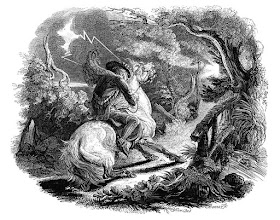Quick idea.
Feels like an awful lot of useless rolling - you could get 5 "nothing happens" results for every encounter, for example. When travelling in an otherwise empty road, the PCs will roll over and over again until they get an encounter.
Why not INVERTING it?
Say, roll 1d6 (or 1d8, 1d10, 1d4+1, etc). That is how many turns (or how many days, etc.) it takes for you to find your next encounter.
A roll of 1 might mean an immediate encounter, with a roll of 6 meaning "nothing happens", and you get to roll again next turn. Which would give you a very small chance of going, say, ten turns (or days, etc.) without any encounters.
Unless you WANT to roll again and again to add tension, etc., this method seems simpler, easier and more effective.
There are other small advantages. For example, if you WANT to have an encounter somewhere along the road, this method will guarantee you eventually get it, while avoiding many encounters in a row.
For example, you could use 1d6+1 (or, say, 2d4) for how many days you can travel into the dark woods without an encounter.
This would mean:
- You are relatively safer before getting too deep into the woods.
- You get a small respite after each encounter.
What do you think? Do you know any games that use such system? Do you see any other pros and cons? Let me know in the comments.


its good but i roll encounters in front of players so they sweat, i do it when they make noise, start a fight, i use smaller dice as they trigger alarms, but i prefer your way for wilderness
ReplyDeleteYeah, making players nervous is a good reason for using the classic method!
DeleteYou make a good point - unless you're using the Overloaded Encounter Die, there's no reason you couldn't save on the number of rolls by using this method.
ReplyDeletePersonally, I think I'd write down the number after rolling it, then make tick marks beside it each time a turn passed (or the players did something else that sped up the clock, as Konsumterra mentions).
It might take a little practice to get used to, but I suspect the countdown could be just as tense as the suspense of rolling each turn.
This "countdown" is a nice idea!
DeleteThere's a slight problem with that approach... a 1 in 6 chance per turn of an encounter does not mean you will definitely get an encounter after six turns, or that you will only get one encounter every six turns. This approach makes it a little too regular, too predictable. Also, it's another thing to track (turns until next encounter.)
ReplyDeleteTrying to think of a way to salvage this, something in between rolling every turn and only rolling once, but I'm not coming up with anything. Maybe something based on rolling 2d6 and doing an immediate encounter if you roll doubles, otherwise using the larger result of the two dice for when to roll again. Not sure if that would work well, either.
This is not hard to solve. Maybe use 1d4, with 1 meaning immediate encounter and the rest meaning "roll again after x turns", or use 1d8 to mean "nothing happens, roll again after y turns" etc.
DeleteSaving the number of rolls does increase randomness (by the central limit theorem).
ReplyDeleteI haven't run the number. but I liked the results in practice!
DeleteI like the idea of rolling for time before next encounter. I feel like such a system could be used to consuder hostility and size. So a large but rather quite terrain (wilderness filed with creatures that would avoid you like bears) would have multiple dice (2d12 days). But if you are in an enemy complex, the area is small (1 die) and response time is fast (1d6). Characters making noise (such as that fool of a Took in Moria) reduce the time.
ReplyDeletePerhaps this can be time to become aware, with d4s being used for mobilisation and arrival.
It's not perfect as I have written, but it could work well.
It also might be too many tables, but I am always on the fence with 3.x style "tables for everything". On one hand, there is a lot of it. On the other hand, it can do some nice scalinh effects.
Yes, sounds like a good idea, you could roll distance of encounter and type of encounter all at once, if you wanted.
Delete